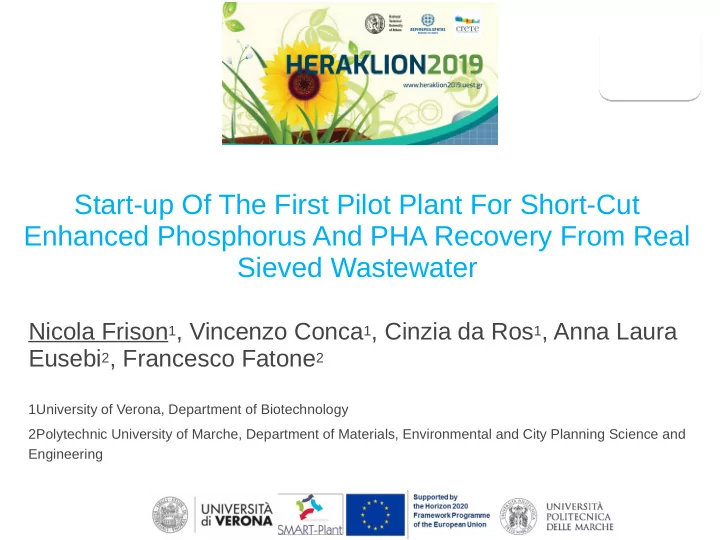

Start-up Of The First Pilot Plant For Short-Cut Enhanced Phosphorus And PHA Recovery From Real Sieved Wastewater Nicola Frison 1 , Vincenzo Conca 1 , Cinzia da Ros 1 , Anna Laura Eusebi 2 , Francesco Fatone 2 1University of Verona, Department of Biotechnology 2Polytechnic University of Marche, Department of Materials, Environmental and City Planning Science and Engineering
OUTLINE The world needs new resources…from wastewater; The water industry consumes about 1% of the overall electricity (Caldwell, 2009; 2° Eur Water and Wastewater Conf); Activated sludge is the major energy consumer (ca 55% of the energy use); The water factory concept of the future: « Not Dissipate » but « Upgrade » low cost carbon source into high added value bioproducts (IWA Resource Recovery Cluster, 2016). 2
HORIZON 2020 – SMART-PLANT PROJECT Heat Electricity Treated wastewater Wastewater Am m onum sulphate S truvite Organic compounds C ellulose Phosphorus richbiosolids Biocomposite Bioplas cs 3
BIOREFINERY OF CELLULOSIC PRIMARY SLUDGE (CPS) Up to 10 Kg/PE y (Ruiken et al., 2013) 350µm Crutchik et al., 2018 4
OBJECTIVE Recovery of cellulosic primary sludge (CPS) through dynamic rotating belt filter; Start-up and operation of the Short-cut Enhanced Phosphorus and PHA recovery pilot plant at the Carbonera WWTP (owned by Alto Trevigiano Servizi Srl) Selection of PHA storing bacteria during the via-nitrite nitrogen removal from anaerobic supernatant (aerobic feast and anoxic famine); Mass balance around the system and recovered (organics) resources 5
SCEPPHAR: PROCESS CONFIGURATION WW Microscreen (350 μm) Municipal 1° step Effluent wastewater Biological nutrients removal Liquid Stream Cellulosic primary Sludge recycle sludge Waste 2° step Activated Biogas Sludge Fermentation of cellulosic sewage sludge Separation Anaerobic Solid Stream Digestion Struvite Mg(OH) 2 4° step 3° step Anaerobic VFAs Aerobic/Anoxi Supernatant Nitritation Treated anaerobic feast/famine SBR supernatant SBR 5° step Selected biomass PHA VFAs Batch for PHA recovery accumulation Frison et al., 201 6
ROTATING BELT FILTER FOR CELLULOSIC PRIMARY SLUDGE (CPS) RECOVERY Fine mesh size: 350 µm Wastewater Flowrate: 29-40 m 3 /h Fixed surface contact area: 0,24 m 2 Variable belt rotation speed Average TSS removal = 45-50% 7
FERMENTATION UNIT FOR SCFAS PRODUCTION FROM CPS • Volume: 3.0 m 3 • Operating T emperature: 37°C • HRT: 4-5 days • Probe for the monitoring of th infmuent TSS concentration 8
SHORT-CUT ENHANCED PHOSPHORUS AND PHA RECOVERY (SCEPPHAR) Nitritation Crystallize SBR r Equalization tank Biomass selection SBR PHA Ceramic accumulatio membrane n 9
CHARACTERISTICS OF THE FERMENTATION LIQUID Parameter Unit Average Min Max pH - 4,9 4,8 5,0 VFAs mgCOD/L 17467 13993 23564 NH 4 -N mgN/L 283 252 307 PO 4 -P mgP/L 68 44 82 Observed VFAs yield around 0.40 mgCOD/gVSS fed COD:N:P ratio in the liquid fraction ~ 257:4:1 HPr to HAc ratio >2 (PHBV) Phosphorus (and fraction of ammonia) recovered as P salts forms. 10
NITRITATION SBR Run 1 Run 2 Run 3 TKN infmuent TKN effmuent NO2-N out Run 1: not heated; Period 2: heated In Run 2 the vNLR was increased up to 1,55-1,60 kgN/m 3 day (T = 28°C); In Period 3 the observed nitritation rate was 55-60 mgN/L h, 80-90% of the nitrogen was nitrified; 11
SELECTION SBR Nitrite removal efficiency around 85%; The kd (@20°C) was 8-10 mgN/gVSS h (driven by PHA degradation); Feast/Famine ratio was 0,15 – 0,20 min/min 12
% P H A in t h e b io m a s s c e lls PHA ACCUMULATION % o f P H A ( g P H A / g M L S S x 1 0 0 ) 50% 40% Y i e l d ( g P H A / g C O D V F A ) ; 30% 20% 10% 0% 0,0 1,0 2,0 3,0 4,0 5,0 6,0 7,0 Time (h) 1,00 0,90 Yield PHA/VF A %PHA 0,80 100% HB 65% HB 0,70 35% HV 0,60 0,50 0,40 0,30 0,20 0,10 0,00 Acetic Acid CPS fermentation liquid 13
MASS BALANCE AROUND THE SYSTEM Sieved Municipal Wastewater Wastewater 13-15 kgSS/PE (adapted from To mainstream Metcalf&Eddy, 2013) y Wastewate 25-30 kgSS/PE y wastewater ~ 4 kgN/PE r Sieving treatment 4 kgN/PE year year CPS VFAs PHA 13-14 5-5,5 kgCOD/PE Nitritation and ~ 1 kgPHA/PE y Fermentati y kgSS/PE y Selection SBRs : on Y X/VFA = 0.32 Effjciency gVSS/gCOD VFA 0,38-0,40 gCOD VFA /gVS Accumulation PHA Treated reject Y PHA/VFA = 0.36-0.42 S water gPHA/gCOD VFA 0,06 kgN/PE y Nitrogen T o biogas from reject production water 0,4 kgN/PE y 14
ESTIMATED COST OF CHEMICALS FOR PHA EXTRACTION: CHEAP AND/OR GREEN? Extraction recovery efficiency: 75% Purity of the extracted PHA: 90-95% without extensive polishing Extraction with «Green-Chemicals » : 1,2 Euro/kgPHA extracted (currently very affected by the scale of the process) SDS-Sodium hypochlorite: 0,29 Euro/kgPHA extracted (adapted from CalRecycle, 2013) Courtesy of Biotrend SA (Portugal) 15
FIRST BIOCOMPOSITES FROM RAW PHA- ACCUMULATED BIOMASS 10 cm 10 cm 10 cm Dried Dried Dried accumulated accumulated PHA accumulated PHA PHA Biomass Biomass + 20% Biomass + 20% of (105°C for 24 h) of PHBV PE Courtesy of Yonghui Zhou, University of Brunel (UK) 16
CONCLUSIONS Cellulosic primary sludge is suitable for the production of VFAs (0,40 gCOD VFA /gVSS); The SCEPPHAR system allows the integration of the PHA production from sewage sludge with the nitrogen removal via-nitrite from the reject water through the aerobic-feast and anoxic-famine regime; The nitrogen removal efficiency was around 85%; Observed PHA production was around 1 kgPHA/PE y. The productivity will be validated during the two years of Smart-Plant Project. 17
Thank you for your attention! Nicola Frison 1 , Vincenzo Conca 1 , Cinzia da Ros 1 , Anna Laura Eusebi 2 , Francesco Fatone 2 1 University of Verona, Department of Biotechnology 2 Polytechnic University of Marche, Department of Materials, Environmental and City Planning Science and Engineering
Recommend
More recommend